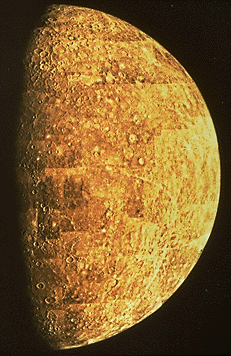Strange New Findings About the Planet Mercury
March 27, 2012
Sometimes things are not as simple as they appear. Take the planet Mercury, for instance. In a very short time, the smallest planet in the solar system (sorry Pluto, you’re no longer a planet) has gone from a simple hunk of rock, much like Earth’s moon, to one of the most unusual planets ever studied. For years, most astronomers thought that Mercury formed early in the solar system’s history and has since remained pretty much unchanged. New evidence shows a planet whose more recent history includes active volcanoes, a shifting crust, and other activities once thought to have ended billions of years ago. Some of these activities may result from the fact that Mercury is slowly shrinking. The shrinking would explain why the outer layer of the planet is buckling and cracking. A closer look at the surface also shows evidence of lava flows having occurred much more recently than previously thought.

The MESSENGER space probe has revealed surprising new findings about the smallest planet in the solar system. (Courtesy of NASA)
The planet’s surface is not the only surprise. Mercury may also have an internal structure like no other planet yet studied by scientists. Mercury appears to have a core consisting of three layers. Earth has only two such inner layers. Both Mercury and Earth have an inner core of solid metal surrounded by a second layer of liquid metal. Unlike Earth, Mercury appears to have a third layer made of solid iron and sulfur. Many scientists now speculate that this possible third layer of core explains one of the great mysteries concerning Mercury. Scientists have long wondered how the planet could be so small and yet have a much greater mass than the other inner planets–Venus, Earth, and Mars–for its size.
The new data on Mercury was collected by the MErcury Surface, Space ENvironment, GEochemistry and Ranging (MESSENGER) space probe. Launched in 2004 by NASA, MESSENGER began a one-year mission orbiting Mercury in early 2011 (which NASA scientists have now extended). The probe reached the planet after a more than five-year tour of the inner solar system. The long, looping route involved three close fly-bys of Mercury along with close approaches to Venus and Earth.
Just how loopy was the route MESSENGER took? Mercury is only about 20 percent farther from Earth than Mars when those planets pass closest to Earth. Yet, a probe going to Mars travels for less than a year. By comparison, MESSENGER took more than five years to reach Mercury.
Additional World Book articles
- Probing the Planets (a special report)
- Space Exploration 2004 (Back in Time article)
- Space Exploration 2008 (Back in Time article)
- Space Exploration 2009 (Back in Time article)
- Space Exploration 2011 (Back in Time article)


